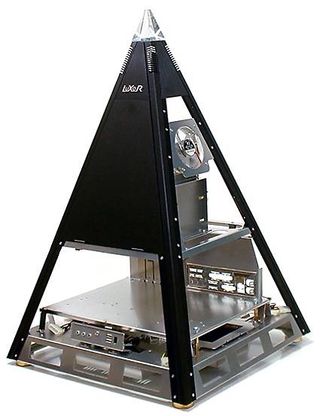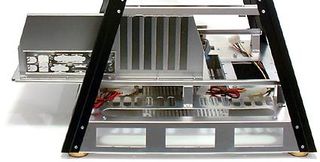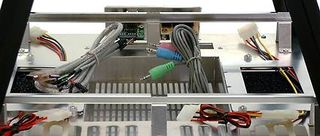Four Unique ATX Cases Compared
Internal Construction
All panels use sliding tabs at the top and middle of the case, held into position by two thumbscrews at the bottom edge. Removing these thumbscrews allows the panel to drop into the released position.

Also seen above is one of the two lighted 80 mm exhaust fans that occupy the upper portion of both sides.
The power supply mounts beneath the motherboard tray using only two screws. Flanked by an 80 mm intake fan on each side, the power supply cage is roomy enough even for extended-length power supplies, but the spare room in front of standard-length power supplies provides a handy place to stash cables.

Rather than the super-powered laser found atop the Luxor Casino, the Luxor Pyramid ATX case uses a reflector and high-intensity flashlight bulb to project a sun pattern on the ceiling when lit.

A completely removable slide-out motherboard tray eases assembly. Note that this case supports only six card slots, as the seventh position is blocked by the case's tapered sides.

Also located beneath the motherboard tray are two hard drive mounting plates. Resting on silicone dampening grommets, holes in the middle of these plates allow filtered air from the intake fans to enhance drive cooling.

Here is where things begin to take a turn to the surreal: sound and IEEE-1394 FireWire cables are designed for use with the motherboard's rear ports rather than internal headers, but the USB cable is designed for use with a motherboard's internal break-out connector. Furthermore, even though internal USB breakout headers have been standardized for around six years, this cable uses eight individual pins for compatibility with earlier, nonstandard configurations.
Stay on the Cutting Edge
Join the experts who read Tom's Hardware for the inside track on enthusiast PC tech news — and have for over 25 years. We'll send breaking news and in-depth reviews of CPUs, GPUs, AI, maker hardware and more straight to your inbox.
Current page: Internal Construction
Prev Page Suffering For Art's Sake: The Luxor Pyramid Next Page Component InstallationMost Popular


